This probe is available from Sigma.
| Probe | Negative control | |
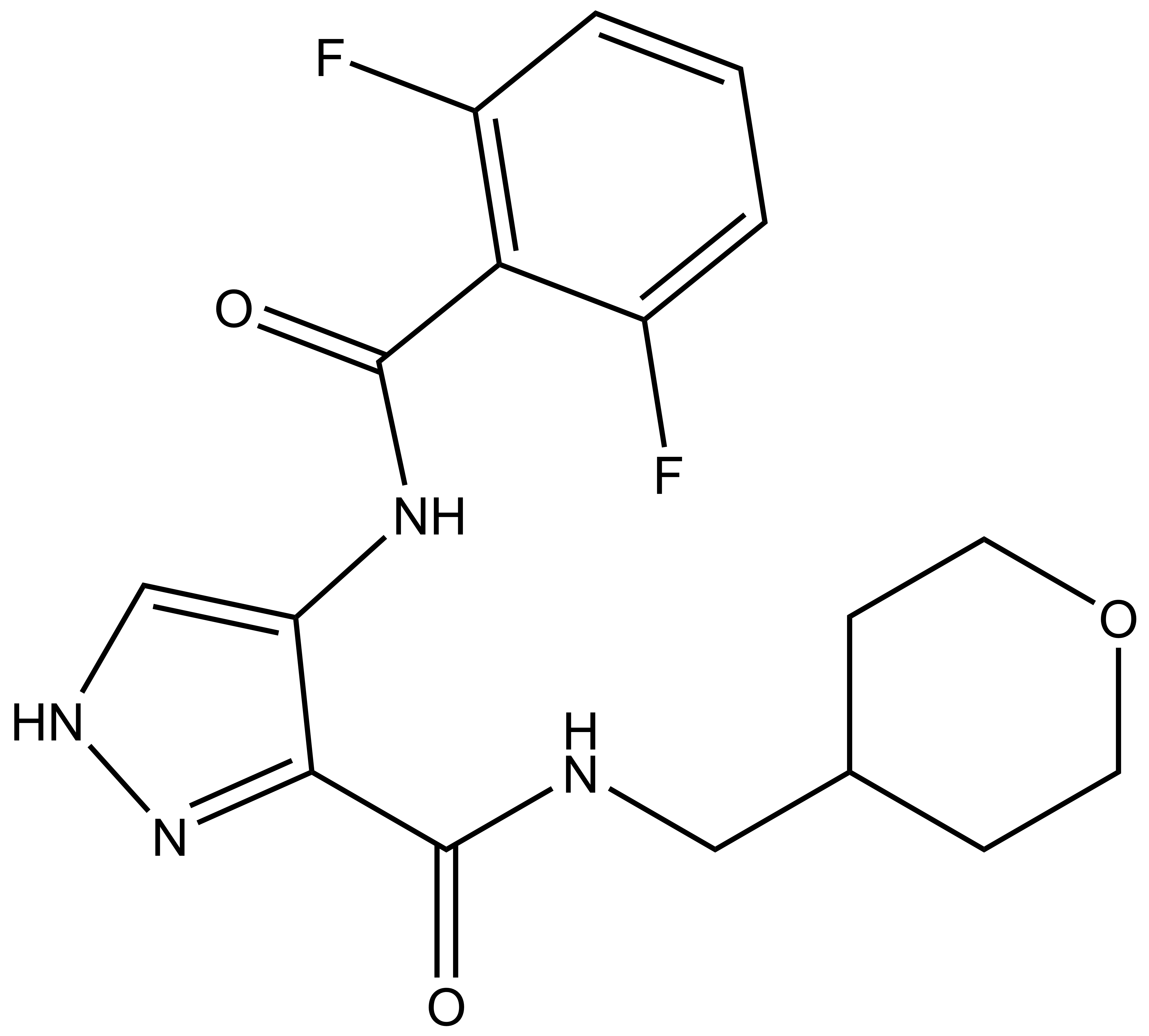 |
| 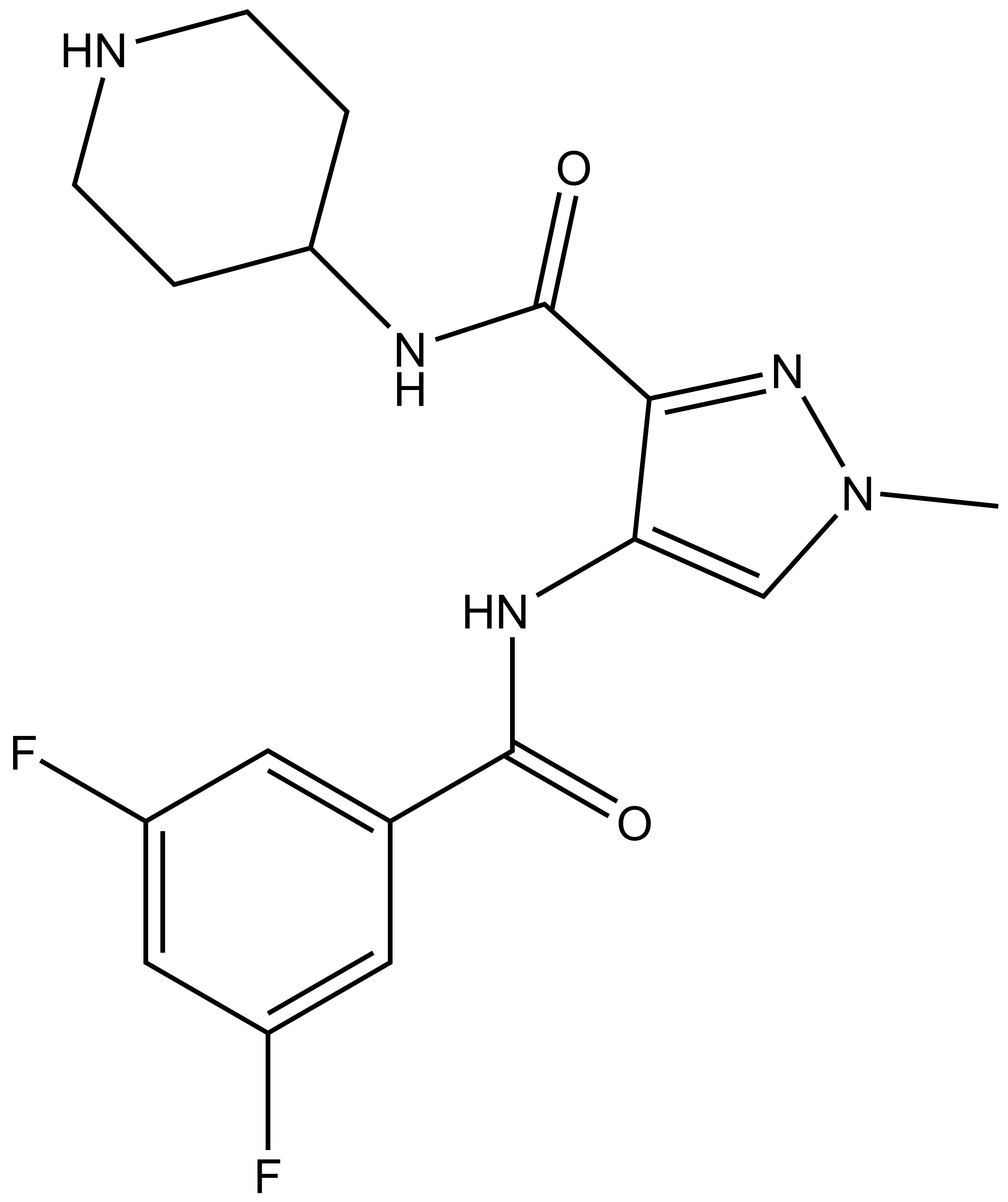 |
SGC-GSK3-1 |
| SGC-CDKL5/GSK3-1N |
From a library of AT-7519 analogs, we identified a potent and cell-active chemical probe (SGC-GSK3-1) that inhibits glycogen synthase kinase-3 (GSK3⍺ and β). Comprehensive evaluation of kinome-wide selectivity confirmed that this GSK3 probe demonstrates remarkable selectivity. A structurally similar analog (SGC-CDKL5/GSK3-1N) was characterized as a negative control that does not bind to GSK3⍺ or GSK3β in corresponding cellular target engagement assays. At nanomolar concentrations, our GSK3 chemical probe promoted motor neuron survival when iPSC-derived motor neurons were exposed to ER stress. When used at an appropriate concentration (<500 nM) in cells, SGC-GSK3-1 is exquisitely selective for GSK3⍺ or GSK3β. Our chemical probe set can be used alongside other potent and selective, structurally divergent GSK3 inhibitors to characterize the impacts of GSK3 inhibition on downstream biology.
| Probe | Negative control | |
 |
|  |
SGC-GSK3-1 |
| SGC-CDKL5/GSK3-1N |
| Physical and chemical properties for SGC-GSK3-1 | |
| Molecular weight | 364.35 |
| Molecular formula | C17H18F2N4O3 |
| IUPAC name | 4-(2,6-difluorobenzamido)-N-((tetrahydro-2H-pyran-4-yl)methyl)-1H-pyrazole-3-carboxamide |
| ClogP | -0.52 |
| PSA | 96.11 |
| No. of chiral centers | 0 |
| No. of rotatable bonds | 7 |
| No. of hydrogen bond acceptors | 6 |
| No. of hydrogen bond donors | 3 |
| Storage | Stable as a solid at room temperature. DMSO stock solutions (up to 10 mM) are stable at -20oC |
| Dissolution | Soluble in DMSO up to 10 mM |
| Physical and chemical properties for SGC-CDKL5/GSK3-1N | |
| Molecular weight | 363.37 |
| Molecular formula | C17H19FN5O2 |
| IUPAC name | 4-(3,5-difluorobenzamido)-1-methyl-N-(piperidin-4-yl)-1H-pyrazole-3-carboxamide |
| ClogP | -0.32 |
| PSA | 88.05 |
| No. of chiral centers | 0 |
| No. of rotatable bonds | 6 |
| No. of hydrogen bond acceptors | 6 |
| No. of hydrogen bond donors | 3 |
| Storage | Stable as a solid at room temperature. DMSO stock solutions (up to 10 mM) are stable at -20oC |
| Dissolution | Soluble in DMSO up to 10 mM |
SMILES:
SGC-GSK3-1: O=C(NCC1CCOCC1)C2=NNC=C2NC(C3=C(C=CC=C3F)F)=O
SGC-CDKL5/GSK3-1N: O=C(NC1CCNCC1)C2=NN(C=C2NC(C3=CC(F)=CC(F)=C3)=O)C
InChI:
SGC-GSK3-1: InChI=1S/C17H18F2N4O3/c18-11-2-1-3-12(19)14(11)16(24)22-13-9-21-23-15(13)17(25)20-8-10-4-6-26-7-5-10/h1-3,9-10H,4-8H2,(H,20,25)(H,21,23)(H,22,24)
SGC-CDKL5/GSK3-1N: InChI=1S/C17H19F2N5O2/c1-24-9-14(22-16(25)10-6-11(18)8-12(19)7-10)15(23-24)17(26)21-13-2-4-20-5-3-13/h6-9,13,20H,2-5H2,1H3,(H,21,26)(H,22,25)
InChIKey:
SGC-GSK3-1: OCQCKUTZHBQNEI-UHFFFAOYSA-N
SGC-CDKL5/GSK3-1N: ODZBDODDFLVDQZ-UHFFFAOYSA-N
SGC-GSK3-1 was profiled in the DiscoverX scanMAX assay against 403 wild-type kinases at 1 μM. Only 5 kinases showed PoC <10 giving an S10(1 μM) = 0.012. When the PoC <35 fraction was examined, 15 kinases were included (S35(1 μM) = 0.037). Potential off-targets within the S35(1 μM) fraction were tested via biochemical enzymatic/binding assays plus NanoBRET target engagement assays for CDKL5, GSK3⍺, GSK3β, and DYRK1B. Data corresponding with off-target kinase activity is shown in the table below.
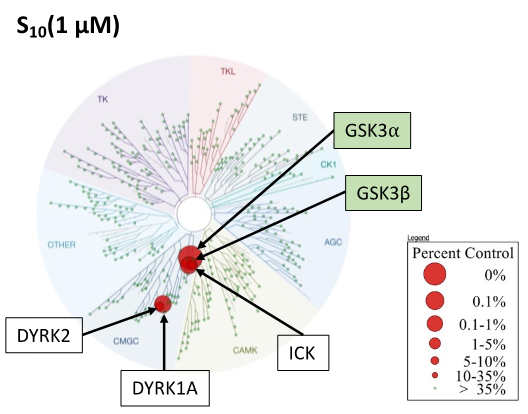
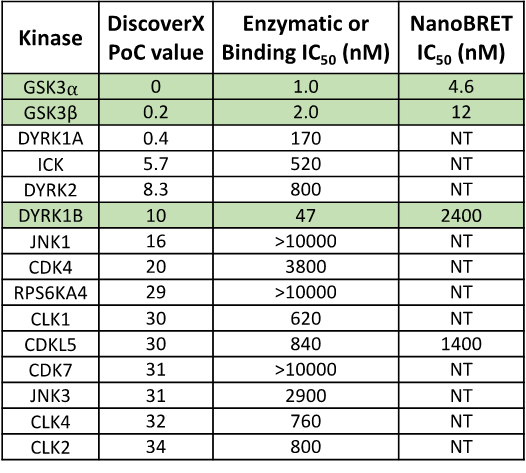
Figure 2: SGC-GSK3-1 was profiled in the DiscoverX scanMAX assay against 403 wild-type kinases at 1 μM and off-target kinases inhibited PoC <35 were tested in an orthogonal assay. Rows colored green are GSK3⍺, GSK3β, and DYRK1B. No other kinases demonstrate enzymatic IC50 values within 30-fold of the GSK3β enzymatic IC50 value.
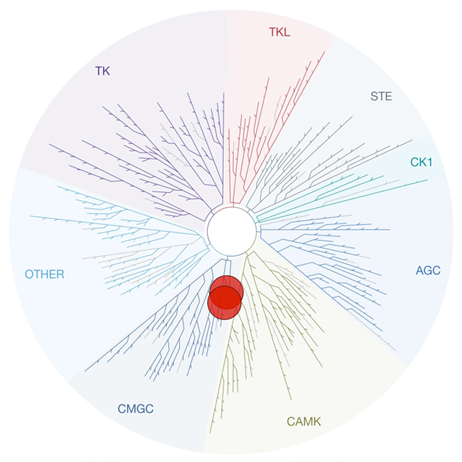
Figure 1: Kinome tree with GSK3⍺ and GSK3β highlighted as red circles. Illustration is reproduced courtesy of Eurofins DiscoverX (http://treespot.discoverx.com).
Biological activity summary:
A NanoBRET assay was utilized to assess the binding affinity of SGC-GSK3-1 to CDKL5, GSK3⍺, GSK3β, and DYRK1B. The negative control shows no binding affinity for GSK3⍺ or GSK3β.


Figure 3: SGC-GSK3-1 was profiled in the GSK3⍺ and GSK3β NanoBRET assays.


Figure 4: SGC-CDKL5/GSK3-1N was profiled in the GSK3⍺ and GSK3β NanoBRET assays.
References
Ong, H. W.; Liang, Y.; Richardson, W.; Lowry, E. R.; Wells, C. I.; Chen, X.; Silvestre, M.; Dempster, K.; Silvaroli, J. A.; Smith, J. L.; Wichterle, H.; Pabla, N. S.; Ultanir, S. K.; Bullock, A. N.; Drewry, D. H.*; Axtman, A. D.* Discovery of a potent and selective CDKL5/GSK3 chemical probe that is neuroprotective. ACS Chem Neurosci 2023, 14, 1672–1685; 10.1021/acschemneuro.3c00135.
Ong, H. W.; Liang, Y.; Richardson, W.; Lowry, E. R.; Wells, C. I.; Chen, X.; Silvestre, M.; Dempster, K.; Silvaroli, J. A.; Smith, J. L.; Wichterle, H.; Pabla, N. S.; Ultanir, S. K.; Bullock, A. N.; Drewry, D. H.*; Axtman, A. D.* A potent and selective CDKL5/GSK3 chemical probe is neuroprotective. BioRxiv 2023, doi: 10.1101/2023.02.09.527935.
The field of drug discovery has continuously evolved over time, driven by advancements in scientific understanding and technological innovations. From serendipitous discoveries, such as the discovery of aspirin and penicillin, to targeted pharmacology and high-throughput screenings, the process of identifying new therapeutic agents has undergone significant transformations.
At Structural Genomics Consortium, we are committed to driving advancements in basic and biomedical research that can positively impact the world. We believe that collaborative efforts and innovative solutions are essential for achieving groundbreaking discoveries. Today, we invite researchers from all corners of the globe to stand united in support of renewable antibody resources.
Sign the Petition to Prioritize Renewable Antibody Resources!
Have you ever experienced any of the following research roadblocks?
This probe is available from Sigma and Cayman Chemical.
Its negative control (TH-263) is available for purchase from Cayman Chemical.
| Probe | Negative control | |
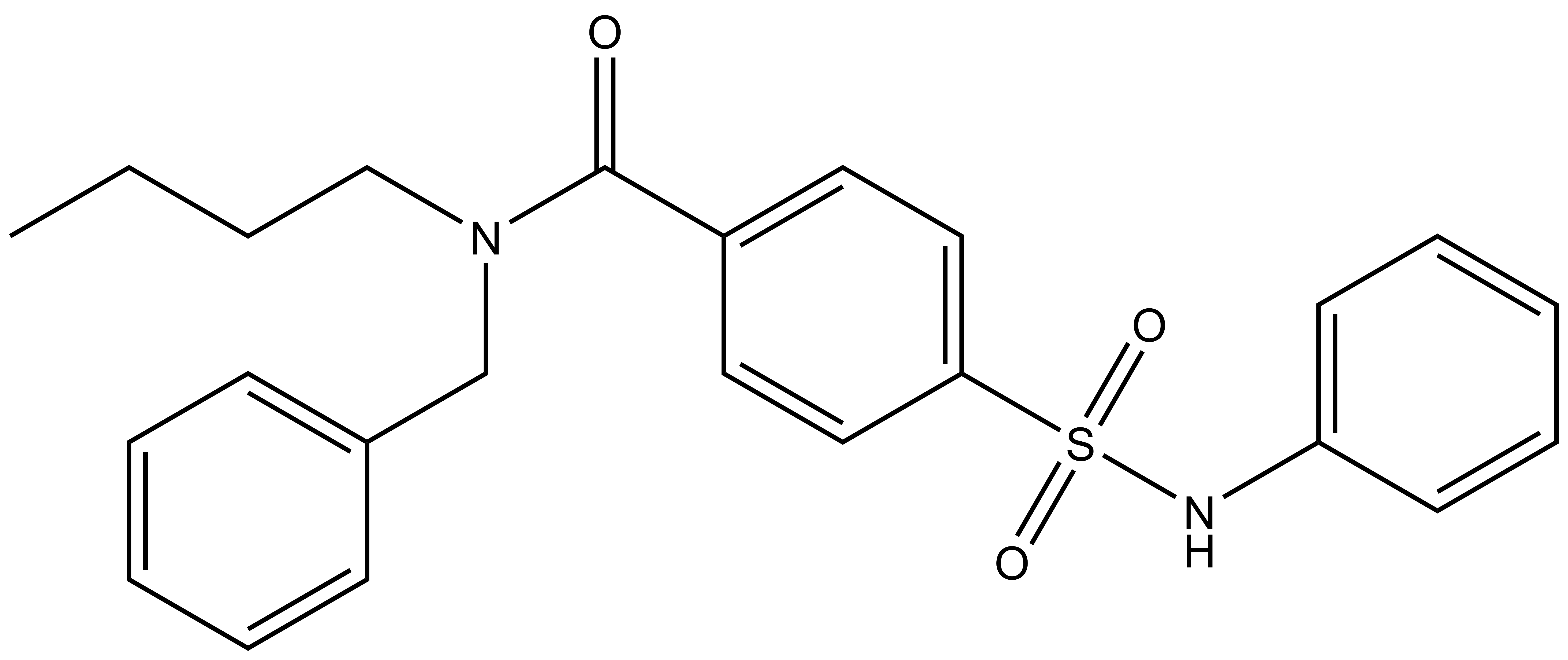 |
| 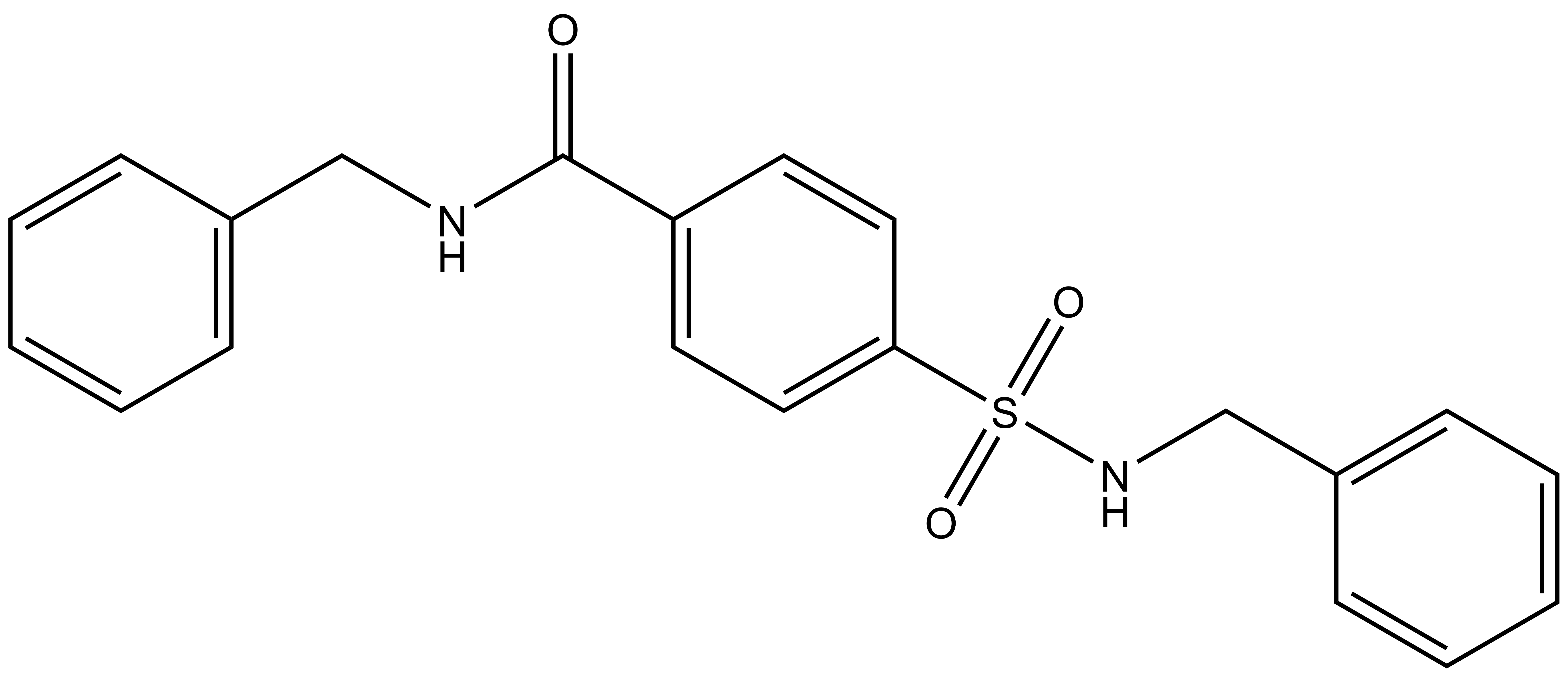 |
TH-257 |
| TH-263 |
LIM kinases belong to the family of cytoplasmic tyrosine-like kinases with dual specificity (serine/threonine and tyrosine). However, known LIMK substrate are usually phosphorylated at serine and threonine residues LIM kinases comprises LIM kinase 1 (LIMK1) and LIM kinase 2 (LIMK2) which show 50% sequence identity in human. Both LIMK1 and LIMK2 present with a unique domain organization containing two N-terminal LIM domains, a PDZ domain, a proline/serine-rich domain and a C-terminal kinase domain [1].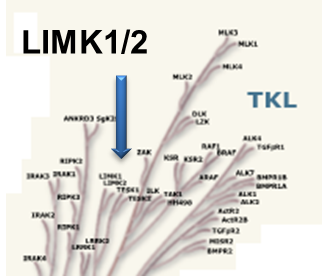
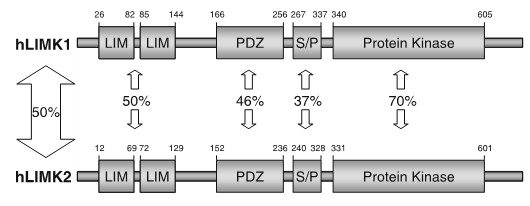

Both proteins are expressed widely in embryonic and adult tissues, but show some cell-type specific expression. Accordingly, the two kinases have overlapping functions, but appear non-redundant. Knockout studies in mice show that LIMK1 is required for development of the central nervous system [2], whereas LIMK2 knockout impairs the activity of testicular germ cells [3].
LIMKs are effectors of cell morphology and motility and apoptosis by regulating the actin cytoskeleton. The LIMKs signal downstream from Rho GTPases and are activated by phosphorylation of the activation loop by upstream kinases, including Rho kinase (ROCK), PAK1/2/4 and MRCKα. The best characterized LIMK substrates are cofilin1 (non-muscle cofilin), cofilin2 (muscle cofilin) and destrin (actin depolymerizing factor, ADF). Phosphorylation of cofilin serine-3 inactivates the actin severing ability promoting F-actin polymerization, stress fibre formation and focal adhesion formation [4].
LIM kinases can shuttle between the cytoplasm and the nuclear compartment of a cell, a process tightly regulated by association with other partners such as p57kip2 and phosphorylation in the activation segment by PAK kinases [1]. Inhibition of LIMK hyper-stabilizes mitotic spindles inducing a G2/M cell cycle block suggesting an important role for these kinases in microtubule dynamics [5].
Increased phosphorylation of LIMK1 has been reported in neurons in areas affected with Alzheimer Disease [6]. LIM kinases play important roles in cancer metastasis like highly invasive prostate and breast cancer, which is reversed by gene silencing [7, 8]. LIMK1 overexpression is also found in malignant melanoma, as well as most tumour cell lines. Other applications for LIMK inhibitors are open-angle glaucoma [9]. In addition, LIMK1 interacts with the long isoform of the type II bonemorphogenetic protein (BMP) receptor contributing to the pathology of Fragile X syndrome, a common inherited form of intellectual disability [10].
TH-257 is a chemical probe for LIMK1 and LIMK2. TH-257 is an allosteric inhibitor targeting a binding pocket induced by an αC and DFG-out conformation. It potently inhibits cofilin phosphorylation with an IC50 of 84 nM for LIMK1 and 39 nM for LIMK2 in a RapidFire MS assay. TH257 is exquisitely selective and no significant activity against the wider kinome has been observed in the KINOMEscan assay (Dx) at 1 μM (IC50 >> 50 % inhibition). In a life cell NanoBRET assay (Promega) TH257 has an IC50 of 250 nM against ectopically expressed full-length LIMK1 and 150 nM LIMK2, respectively.
A chemically related negative control compound, TH-263, is provided.
| Probe | Negative control | |
 |
|  |
TH-257 |
| TH-263 |
| Physical and chemical properties for TH-257 | |
| Molecular weight | 422.2 |
| Molecular formula | C24H26N2O3S |
| MollogP | 5.138 |
| PSA | 57.08 |
| No. of chiral centres | 0 |
| No. of rotatable bonds | 10 |
| No. of hydrogen bond acceptors | 6 |
| No. of hydrogen bond donors | 1 |
| Physical and chemical properties for TH-263 (Negative Control) | |
| Molecular weight | 380.1 |
| Molecular formula | C21H20N2O3S |
| MollogP | 3.636 |
| PSA | 66.41 |
| No. of chiral centres | 0 |
| No. of rotatable bonds | 8 |
| No. of hydrogen bond acceptors | 7 |
| No. of hydrogen bond donors | 2 |
SMILES:
TH-257: CCCCN(C(C1=CC=C(S(NC2=CC=CC=C2)(=O)=O)C=C1)=O)CC3=CC=CC=C3
TH-263: O=S(C1=CC=C(C=C1)C(NCC2=CC=CC=C2)=O)(NCC3=CC=CC=C3)=O
InChI:
TH-257: InChI=1S/C24H26N2O3S/c1-2-3-18-26(19-20-10-6-4-7-11-20)24(27)21-14-16-23(17-15-21)30(28,29)25-22-12-8-5-9-13-22/h4-17,25H,2-3,18-19H2,1H3
TH-263: InChI=1S/C21H20N2O3S/c24-21(22-15-17-7-3-1-4-8-17)19-11-13-20(14-12-19)27(25,26)23-16-18-9-5-2-6-10-18/h1-14,23H,15-16H2,(H,22,24)
InChIKey:
TH-257: VNCIWNGCMAKKEO-UHFFFAOYSA-N
TH-263: QDGVJMITKNOVTP-UHFFFAOYSA-N